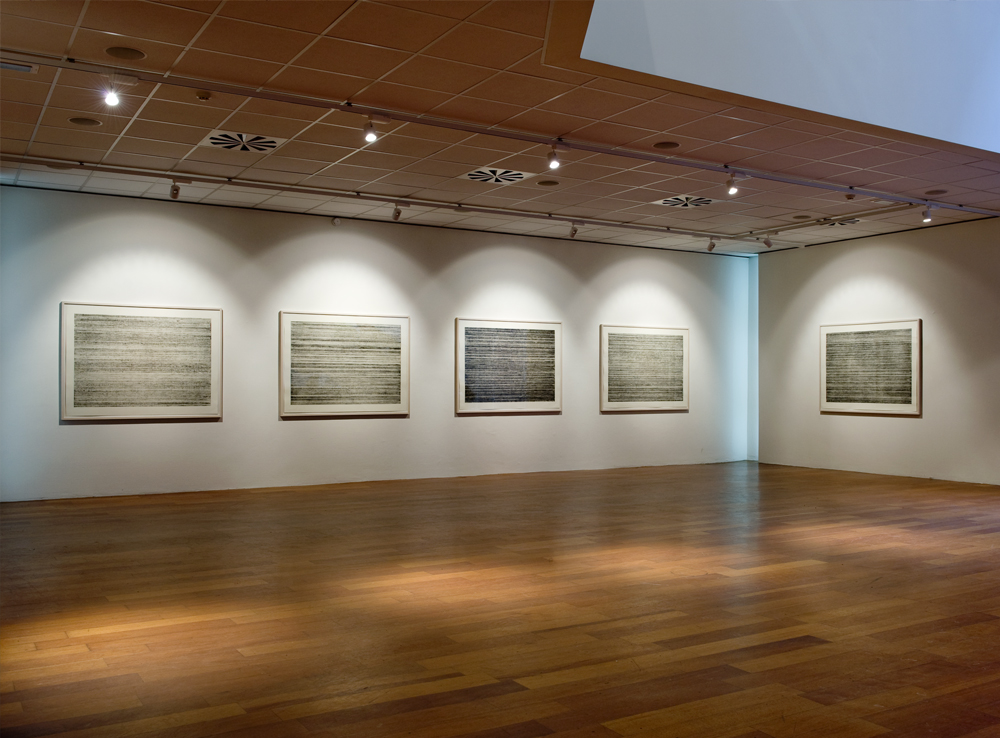Chaos as Solution
by Saskia van de Wiel
2010
Saskia van de Wiel is art historian and curator Museum Van Bommel Van Dam.
Catalog Ruis/Noise can be ordered by e-mail or ERASMUS bookshop Amsterdam www.erasmusbooks.nl.
28×21 cm | 36 p. | 10,- ex. porto.
Chaos as Solution
To what extent is it possible to restore the world to an orderly whole? Is this something art could do? This flashes across my mind while looking at etches by Alexandra Roozen, on a large format, one by one and a half metres. At first sight her work seems tightly organised, but on closer inspection it appears to depend on so many factors that its outcome is hard to figure out, let alone to understand.
Unknown Formulas
The etches I’m referring to are made up of horizontal lines, that are at times placed close together and then again more loosely against each other. Together the lines form a tight lattice in which light and darker bands can be recognised. Each work has its own density and pattern, and with that its own feel. Some works are darker, heavier; others strike you as lighter and thinner. The line-pattern looks like it is cut out of a larger whole, an endless landscape, that extends itself upwards and downwards, to the left and right, far beyond the frame of the work.
From afar, the works are reminiscent of ripples on water, or the vibrations of warm air. A vibrating and moving whole that could be the visualisation of sound or some other physical phenomenon. But when seen from nearby, this impression changes completely. The horizontal lines appear to be composed of minute elements: tiny curves, or brief strokes. Not a single line is the same intentionally. Waves and accents alternate and disappear here and there almost seamlessly into each other.
Because the marks on a horizontal line are placed next to each other, they bring up associations with script and writing. It could refer to a code or a musical score. One reads the characters almost automatically from left to right. When seen this way, they seem to depict a series of moments, in which one almost appears to arise coincidentally from the other. As if an unknown formula was being employed to transform one element into the next and to arrive at a seemingly endless series in this way.
Order or Randomness
It is hard to fathom the nature and origin of the characters. They are strongly reminiscent of notation and calligraphy, but do not appear to have been produced by hand. For that the characters placed next to each other are too sharp and rigid in form. On some lines there are recognisable series of almost identical strokes. It seems impossible for these to have been placed loosely by hand. The firm horizontal lines also suggest that a machine has been used to arrive at these forms.
The artist has indeed driven the etching needle mechanically. A drill has been used to draw furrows in the etching plate. A metallic slat fastened to the paper has created a grip. The tracks that are cut depend on the angle between the needle and the plate, the speed of rotation of the drilling head, and the speed with which the artist moves along the plate. Although practice has led to a certain amount of control, the resulting pattern can never be predicted exactly.
The process that follows also includes factors that cannot be controlled completely. The etching plate is inked and wiped off. The large surface of the plate ensures that it is impossible to carry this out in a perfectly steady way. It is still handwork. For the printing the dampness of the sheet of paper is important. The dampness determines the extent to which the ink is absorbed, but is hardly measurable. As there are always variables that cannot be influenced and values that cannot be perceived, chance also plays a role in obtaining the final image.
Essence of the Technique
Roozen looks for the fundamental features of a technique. Etching is in essence nothing more than placing lines, marks, and transferring these elements on to paper or another surface by using different instruments. It is about the contrast between black and white, between “figure” and “ground”.
To arrive at the core of the dry-point technique, she strips it as far as possible. The etches are reduced to merely a few elements. Only one colour, or rather non-colour, is used: black. The tracks of the rotating needle are clearly shown by drawing exclusively straight lines and by simply placing them below each other. Roozen explores the room for manoeuvre allowed by little elements and the variation that can be achieved with it. She shows how surfaces can be composed from lines in different shades of grey. We are urged to look carefully at the used construction elements and the effects that these can create. The remaining compositional means are restricted to a minimum in order to focus our attention on this.
The artist aims for the lightest possible plate tone, through which the white of the paper forms the basis for the engraved patterns. The white background ensures uncertainty regarding the process. As it plays a decisive role in the image, the work does not resemble a print off a plate, but a sum of repeating lines and accents. One cannot say for sure whether the patterns have been printed or drawn by hand. Paradoxically, it becomes difficult to name the technique, precisely when its characteristic features are explored and revealed so explicitly.
In all her works, Roozen looks for a form that exemplifies a particular technique. Her original training is in drawing. Her drawings show a free search for form, tone and the moment when a suggestion of depth arises. An exploratory, direct play for which the pencil, held directly in the hand, is the perfect tool. Her reliefs are the result of a process with several phases. A wooden or plastic plate is frequently perforated and transferred in rubber. The resulting forms appear natural in their simplicity, but could not have been obtained in any other way.
Something to Hold on to
Generally speaking, as a viewer, one is inclined to look for order and cohesion. In Roozen’s work you hardly come across both these elements. In the etches, the different parts are recognisable, such as the characters that form lines, and the lines that form planes, but these parts do not have a meaningful connection with each other. Their order is based on co-ordination, where one simply follows the other. There is no hierarchy of important and less important parts.
Although a logical sequence or causal connection cannot be found between the characters or the lines, as a viewer one persists in looking for it. One subjects the accents and curves to a thorough analysis and looks for a point that reveals something about their origin and unity. The solution to this question lies partly outside the image. One who is familiar with the used technique can figure out the lines and can imagine how the forms were achieved. Still, the matter isn’t quite resolved yet. It remains hard to grasp and to accept that seemingly simple forms can have such a complex impact. You can’t get a grip on the repeating elements, can’t place them in some kind of structure.
It is the search for logic that plays a central role in the etches by Alexandra Roozen. The procedure isn’t chosen for its obscurity or originality, but for the confusing impact of the resulting image on the viewer. The image demands careful observation, retracing what it reminds you of, what is it that determines the mood. As if you find yourself in a field of noise and are trying to tune into the right frequency.
Role of the Artist
The fact that the composition of the work is clear and simple does not mean that there is no room for improvisation during its creation. There is of course a tight organisation. The plan is for the most part fixed before the artist starts to carry it out. Nevertheless, Roozen believes in allowing the space for small experiments as she works. She reserves the right to try out new things and to be surprised by their outcome.
Parts of the working method are adjusted to whatever comes up during the process that is being carried out: an insight or a new solution. Roozen looks intuitively for a balance between the positive and negative, the way the lines are spread across a surface, their density. Not everything is calculated. The artist is not a robot. She is not there to draw up a preconceived plan and then to execute it thoughtlessly. The rules that she imposes upon herself are in fact rules of the game that describe the broader framework and parameters of her work. The precise content is determined by her in the moment itself.
Roozen asks a lot of herself, mentally as well as physically. Besides concentration, quite a lot of muscle power and control is required to draw the large number of lines without making mistakes or slipping. Tiredness, which results inevitably from carrying out such repetitious actions, leads to small differences and interruptions. The body knows its limits; it is not a machine. Therefore, you could say that even though the artist does not work the surface of the etching plate directly, in an indirect way, traces of her body, her handwriting – if you will – are still present in the work.
Together with the frayed nature of the lines and the variety of shades between velvet black and pure white, it is precisely those small irregularities and the unevenness that give the etches a certain humanity. Moreover, combined with the strict composition and the reduction of means, they create a pleasant tension. The etches can therefore not only be placed in a minimalist tradition, but also in a romantic, perhaps even an abstract expressionist one.
The thing that connects this work to both movements is that it gives the perception and interpretation of the viewer a central role. The etches allow us to look carefully and to guess at the source of the impact that they have on us. They force us to search for meaning and sense. We attempt to analyse the system and reduce it to a few rules, only to realise that this is never completely possible. Alexandra Roozen’s work makes it clear that unconsciously, at times desperately and against their better judgement, human beings keep searching for order and something to hold on to, not only in art, but also in the world outside.
Translated from the Dutch by Rose Arora



